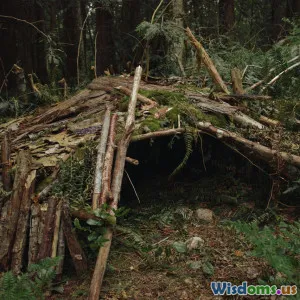
Essential Wilderness Skills for Adventurers
8 min read Master essential wilderness skills for safe and enjoyable outdoor adventures. (0 Reviews)
Essential Wilderness Skills for Adventurers
Introduction
In an age where technology is ubiquitous, the call of the wild continues to resonate with many. The urge to step outside the contrived comfort of our homes and into the vastness of nature can be exhilarating; however, it can also be dangerous without the essential wilderness skills to support your adventure. Whether you're trekking through the mountains, exploring thick forests, or simply spending a night under the stars, knowing the basics of wilderness survival can mean the difference between an adventure of a lifetime and a precursory crisis. This article will walk you through vital survival skills for outdoor enthusiasts. Let's equip you for your next escapade!
1. Navigation Skills
One of the first skills an adventurer must master is navigation. With the vast expanses of wilderness that often seem uncharted, knowing how to find your way is crucial. Here are essential aspects of navigation:
1.1. Map Reading
Understanding how to read a topographical map can illuminate your path through unfamiliar territory. Look for details such as elevation changes, trails, water bodies, and potential hazards. To practice, try building mental maps from navigation logs in familiar terrains.
1.2. Compass Usage
A compass complements the topographical map effectively. Knowing how to use a compass for orienteering is paramount. A basic understanding of bearings and declination will enable you to plot your course accurately.
1.3. Natural Navigation
Natural navigation incorporates the sun, moon, and stars. The North Star, for example, aligns nearly with true north, and the position of the sun provides general directional cues throughout the day.
2. Fire-making Techniques
The ability to make a fire in the wild is not only about warmth; it serves many purposes, including signaling, cooking, and keeping predators at bay. Here’s what you need to know:
2.1. Fire-starting Tools
Traditionally, matches and lighters are used, but it’s prudent to explore alternative methods. Fire starters, like magnesium blocks or flint and steel, can ignite tinder even in adverse conditions.
2.2. Tinder and Kindling
Gather multiple types of tinder such as dry leaves, pine needles, or dryer lint. Understanding the ratios, and how to build your fire pit structure from tinder to kindling to larger logs, will increase your chances of success.
2.3. Fire Safety
Always build your fire in a safe location, far from flammable materials. Make sure to follow proper extinguishing protocols after using it to prevent wildfires.
3. Shelter Building
Whether you’re spending an unexpected night in the woods or planning a lengthy trek, knowing how to build a shelter can protect you from the elements. Here’s how to create a compact and effective refuge:
3.1. Types of Shelters
Several shelter types suit different environments. A lean-to utilizes fallen trees as supports, while a debris hut needs only materials found on-site. Knowing how and when to use these will enhance your adaptability.
3.2. Location Matters
Choose shelter locations wisely. Look for level ground away from hazards like falling branches or flooding. Natural windbreaks, such as boulders or substantial vegetation, can help shield your site.
4. Foraging and Water Purification
Resources in nature include edible plants and safe drinking water, but identifying them accurately is vital.
4.1. Foraging Basics
Understand how to identify various plants — like dandelions or wild garlic — that can provide sustenance. Study and practice edible plant identification before venturing out to avoid poisonous species.
4.2. Water Sources and Purification
Locate water sources such as streams and springs. It's essential to employ purification methods such as boiling, using water purification tablets, or DIY gravity filtration systems to ensure safe drinking water.
5. First Aid and Emergency Preparedness
Wilderness adventures can come with unforeseen risks, so being equipped with basic first aid knowledge is imperative.
5.1. First Aid Kit Essentials
Make sure you have a properly stocked first aid kit that includes band-aids, antiseptics, gauze, a whistle, splints, scissors, tweezers, and pain relievers. Knowing how to utilize your first aid kit can save lives.
5.2. Recognizing and Treating Common Injuries
Understand the basics of treating sprains, bites, stings, and hypothermia. Training in CPR and wilderness first aid can further prepare you for emergency scenarios and is often available through local organizations.
6. Survival Mindset
A successful adventure relies heavily on mindset and attitude. The wilderness can test your resolve, but a positive and prepared mindset can make all the difference.
6.1. Staying Calm Under Pressure
Develop stress management techniques to stay calm when faced with adversity. Practicing deep breathing and maintaining perspective can help keep panic at bay while navigating unstable situations.
6.2. Evacuation Knowledge
Understand the nearest exit points and routes in your area for quick evacuations. Legally know paths in your area or consult park rangers before embarking on long treks to prepare for potential emergencies.
Conclusion
Mastering essential wilderness skills can transform your adventures from mundane hikes into unforgettable experiences brimming with confidence and autonomy. As you equip yourself with knowledge about navigation, fire-making, shelter-building, foraging, and first-aid, you prepare for not just survival, but thriving in the great outdoors. So, pack your bags, prepare mentally, and let the wilderness unfurl its mysteries; the thrill of adventure awaits! With these skills, you’re reaching beyond survival—you’re embracing the wild world itself. Happy exploring!
Rate the Post
User Reviews
Popular Posts



















